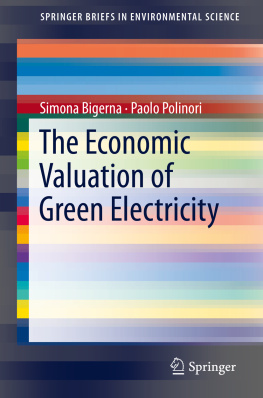Simona Bigerna - The Economic Valuation of Green Electricity
Here you can read online Simona Bigerna - The Economic Valuation of Green Electricity full text of the book (entire story) in english for free. Download pdf and epub, get meaning, cover and reviews about this ebook. year: 2019, publisher: Springer, genre: Romance novel. Description of the work, (preface) as well as reviews are available. Best literature library LitArk.com created for fans of good reading and offers a wide selection of genres:
Romance novel
Science fiction
Adventure
Detective
Science
History
Home and family
Prose
Art
Politics
Computer
Non-fiction
Religion
Business
Children
Humor
Choose a favorite category and find really read worthwhile books. Enjoy immersion in the world of imagination, feel the emotions of the characters or learn something new for yourself, make an fascinating discovery.
- Book:The Economic Valuation of Green Electricity
- Author:
- Publisher:Springer
- Genre:
- Year:2019
- Rating:3 / 5
- Favourites:Add to favourites
- Your mark:
- 60
- 1
- 2
- 3
- 4
- 5
The Economic Valuation of Green Electricity: summary, description and annotation
We offer to read an annotation, description, summary or preface (depends on what the author of the book "The Economic Valuation of Green Electricity" wrote himself). If you haven't found the necessary information about the book — write in the comments, we will try to find it.
The Economic Valuation of Green Electricity — read online for free the complete book (whole text) full work
Below is the text of the book, divided by pages. System saving the place of the last page read, allows you to conveniently read the book "The Economic Valuation of Green Electricity" online for free, without having to search again every time where you left off. Put a bookmark, and you can go to the page where you finished reading at any time.
Font size:
Interval:
Bookmark:

SpringerBriefs in Environmental Science present concise summaries of cutting-edge research and practical applications across a wide spectrum of environmental fields, with fast turnaround time to publication. Featuring compact volumes of 50 to 125 pages, the series covers a range of content from professional to academic. Monographs of new material are considered for the SpringerBriefs in Environmental Science series.
Typical topics might include: a timely report of state-of-the-art analytical techniques, a bridge between new research results, as published in journal articles and a contextual literature review, a snapshot of a hot or emerging topic, an in-depth case study or technical example, a presentation of core concepts that students must understand in order to make independent contributions, best practices or protocols to be followed, a series of short case studies/debates highlighting a specific angle.
SpringerBriefs in Environmental Science allow authors to present their ideas and readers to absorb them with minimal time investment. Both solicited and unsolicited manuscripts are considered for publication.
More information about this series at http://www.springer.com/series/8868

This Springer imprint is published by the registered company Springer Nature B.V.
The registered company address is: Van Godewijckstraat 30, 3311 GX Dordrecht, The Netherlands
The aim of the book is to analyze the relationship between renewable (or green) electricity and citizens, focusing on both the demand side and the supply side. Today the consequences of the use of fossil energy are seen from a different perspective because issues related to climate change are evident worldwide. Thus, climate change and resource depletion are real problems to be addressed for the welfare of society. Renewable energy sources are essential to reduce polluting emissions, but they can produce a range of environmental effects, which might be detrimental to human activities, as attested to by several types of Not in My Back Yard (NIMBY) reactions. This is because renewable energy infrastructure siting usually implies several pros and cons to the local stakeholders involved in the projects. For example, in Italy, according to the last report available in 2016 (Nimbyforum 2017), there are 359 contested facility projects and, among these, 45% involve renewable energy.
Nevertheless, empirical evidence (from the Eurobarometer survey, among other sources) shows that in Italy, as in several European countries, citizens are willing to pay a significant amount to produce renewable electricity. Renewable electricity production involves citizens from two opposite points of view. Indeed, they are involved both as end users and as stakeholders in the construction of the facilities and in the local production process. In this book we analyze this dual role played by citizens in order to evaluate the actual and global public acceptance of renewable electricity generation in Italy.
We address a specific and important area of the economic analysisthe stated preferences methodfocusing on two welfare measures: willingness to pay and willingness to accept.
Consequently, the research evaluates the attitudes of citizens toward the end use of renewable electricity and the likelihood of acceptance of new infrastructure related to renewable electricity generation. Our aim is not to consider all technologies; we focus only on site-specific cases that involve siting controversies. To do this we focus on empirical results in Europe, including Italian case studies, comparing them with our contingent valuation field experiments. Furthermore, in our empirical analysis we explicitly take into account the uncertainty associated with the respondents in order to obtain more robust results.
The book, therefore, is not about how to reconcile consumers and citizens behavior regarding renewable electricity consumption and production; rather, it explores the main determinants of peoples behavior, on the two sides of the market, for better understanding of this phenomenon, to obtain useful information for public and private decision makers. The structure of the book is as follows.
In Chap. we use a meta-analysis to collect and analyze related literature about renewable electricity adoption, taking into account the double role played by the citizens. The main determinants of citizens behavior are analyzed for better understanding of the renewable electricity adoption process.
In Chap. we investigate whether existing wind farms affect respondents attitudes and perceptions toward potential enlargement of wind farms, using a contingent valuation method. We explicitly take into account the existence of respondents heterogeneity in perceiving the new project externalities referring to potential land use conflicts and local opposition. To do this, we use both willingness to pay and willingness to accept measures, and we also appraise the impact of uncertainty, taking into account several degrees of uncertainty, using the numerical scale method.
In Chap. we estimate Italian households willingness to pay for renewable electricity, comparing our results with those of other similar studies conducted worldwide. Furthermore, we use two approaches to treat uncertainty, appraising consumers willingness to pay for renewable electricity, to provide more robust results.
National Wind Energy Association
CExChoice experiment
CVContingent valuation
Font size:
Interval:
Bookmark:
Similar books «The Economic Valuation of Green Electricity»
Look at similar books to The Economic Valuation of Green Electricity. We have selected literature similar in name and meaning in the hope of providing readers with more options to find new, interesting, not yet read works.
Discussion, reviews of the book The Economic Valuation of Green Electricity and just readers' own opinions. Leave your comments, write what you think about the work, its meaning or the main characters. Specify what exactly you liked and what you didn't like, and why you think so.









